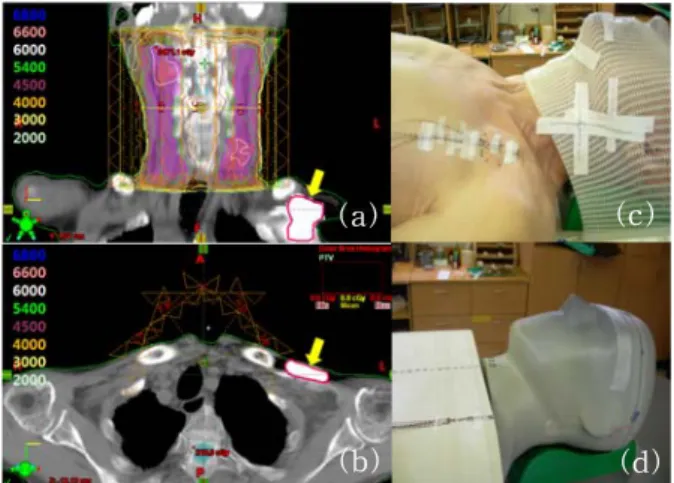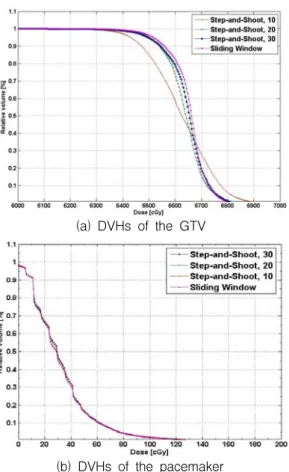2011년도 추계학술발표회 논문요약집 대한방사선방어학회
102_http://www.karp.or.kr
Analysis of Cumulative Dose to Implanted Pacemaker
According to Various IMRT Delivery Methods: Optimal Dose
Delivery Versus Dose Reduction Strategy
Jeong-Woo Lee1,2 ․ Semie Hong1 1
Dept. of Radiation Oncology, Konkuk University Medical Center
2
Research Institute of Health Science, Korea University E-mail: polirain@naver.com
Key words : Pacemaker, IMRT, Step and Shoot, Sliding Window, MOSFET
Materials and Methods
Results and Discussion
Introduction
Cancer patients with implanted cardiac pacemaker occasionally require radiotherapy. Pacemaker may be damaged or malfunction during radiotherapy due to ionizing radiation or electromagnetic interference. Although radiotherapy should be planned to keep the dose to pacemaker as low as possible not to malfunction ideally, current radiation treatment planning (RTP) system does not accurately calculate deposited dose to adjacent field border or area beyond irradiated fields. In terms of beam delivery techniques using multiple intensity modulated fields, dosimetric effect of scattered radiation in high energy photon beams is required to be detailed analyzed based on measurement data. The aim of this study is to evaluate dose discrepancies of pacemaker in a RTP system as compared to measured doses. We also designed dose reduction strategy limited value of 2 Gy for radiation treatment patients with cardiac implanted pacemaker [1].
To evaluate cumulative doses to a implanted pacemaker (5 mm distance from irradiated field border in inferior direction) according to delivery methods, Step-and-Shoot (SS) with intensity levels of 10, 20, and 30 and Sliding Window (SW) were
Fig. 1. Evaluation of the delivered doses on the pacemaker. Calculation doses of a planning system in (a) a coronal, (b) an axial view, and (c) in-vivo dosimetry on skin of the patient's chest, (d) dose verification on a humanoid phantom using mosfet.
adopted in a patient with tongue cancer. Intensity modulated radiation therapy (IMRT) plans for a gross tumor volume (GTV) prescribed with 66 Gy per 30 fractions were simulated in a planning system (Eclipse, ver. 7.3, VMS, Palo Alto, USA) and a treatment unit (21EX, VMS, Palo Alto, USA). Dose volume histograms (DVHs) of implanted pacemaker to dose conformity of GTV were evaluated. Planned doses were verified with and without 2 mm-lead shielder in in-vivo dosimetry under SS technique and a humanoid phantom under both two different delivery techniques (Fig.1) using mosfet detectors (TN-1002RDM, Best Medical Canada, Ottawa, Canada).
(a) (c)
2011년도 추계학술발표회 논문요약집 대한방사선방어학회
제1분과(의료 및 생물)_ 103
Measurement position
Beam delivery technique
SS SW RTP Mosfet RTP Mosfet Humanoid Phantom Without lead shield Upper 2.60 5.63 2.70 5.76 Center 0.60 4.81 0.20 4.68 Lower 0.00 3.77 0.00 3.96 With lead shield Upper - 3.84 - 4.41 Center - 2.60 - 2.34 Lower - 1.69 - 1.95 In-Vivo Without lead shield Upper 3.87 12.91 - -Center 2.11 9.23 - -Lower 0.11 7.00 - -With lead shield Upper - 5.62 - -Center - 3.51 - -Lower - 1.50 - -(b) DVHs of the pacemaker (a) DVHs of the GTV
Fig. 2 Comparison of DVHs depending on beam delivery techniques in IMRT
In plan simulation, estimated doses on the pacemaker position showed little difference depending on delivery techniques, while minimum 7% of dose homogeneity in GTV was higher in SW than SS (Table. 1 and Fig. 2). Calculated doses in RTP were even zero values at lower regions of the pacemaker. Otherwise, average in-vivo dose (9.81 cGy) and measured doses (4.72 cGy) on the phantom were 4 times higher than average planned doses. If we deliver IMRT fields with dosimetric expectation based on underestimated calculation doses, overdoses would be deposited to the pacemaker.
Total accumulated dose of 145 cGy based on in-vivo dosimetry was satisfied with the recommendation criteria to prevent malfunction of pacemaker in SS technique. However, the 2 mm lead shielder enabled the scattered doses to reduce up to 60% and 40% in the patient and the phantom, respectively. The SS technique with the lead
Table 1. Comparison of measured fractional doses using mosfet in different IMRT delivery techniques (SS: step-and-shoot, SW: sliding window)
shielding could reduce the accumulated scattered doses less than 100 cGy. Calculated and measured doses were not greatly affected by the beam delivery techniques.
Conclusion
In-vivo and measured doses on pacemaker position showed critical dose discrepancies reaching up to 4 times as compared to planned doses in RTP. The current SS technique could deliver lower scattered doses than recommendation criteria, but use of 2-mm lead shielder contributed to reduce scattered doses by 60%. The tertiary lead shielder can be useful to prevent malfunction or electrical damage of implanted pacemakers during radiotherapy. It is required to estimate more accurate scattered doses of the patient or medical device in RTP to design proper dose reduction strategy.
Reference
1. J .R. Marbach, M. R. Sontag, J. Van Dyk, and A. B. Wolbarst, AAPM Report No.45 (TG-34)- management of radiation oncology patients with implanted cardiac pacemakers. Med. Phys.

